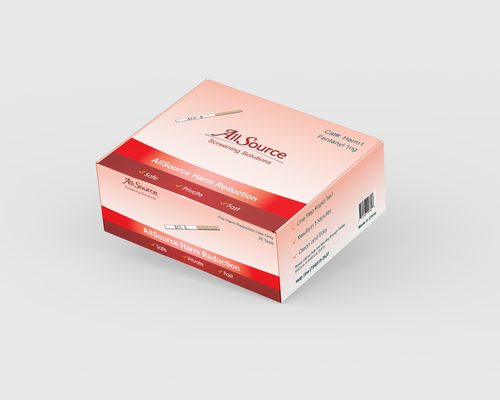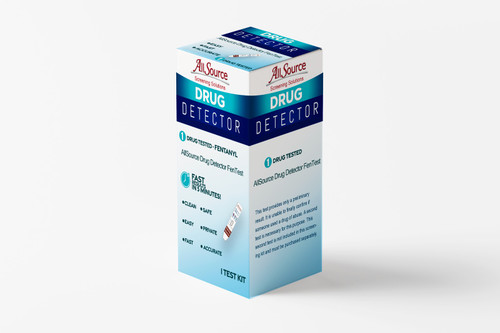AllSource Fentanyl Harm Reduction Tests
Cutoff Level: 1ng/mL
These strips can be used on any surface or powdered substance to determine if Fentanyl is present. The Fentanyl Harm Reduction test can be used on any surface, such as a couch, bed, car, countertop, etc. It will also test powdered substances such as cocaine, meth, etc. to confirm if the drug is laced with Fentanyl.
Intended use
The AllSource Harm Reduction is a one-step lateral flow immunoassay device for the detection of drug residues on suspected surface or in powder. The AllSource Harm Reduction device detects Fentanyl at the cutoff of 1 ng/ml.
The AllSource Harm Reduction provides only preliminary drug test results. For a quantitative result or for a confirmation of a presumptive positive result obtained by the AllSource Harm Reduction, a more specific alternative method such as GC/MS or LC/MS must be used.
This test is for harm reduction use only.
Summary and Explanation
Illegal drug consumption contributes to many accidents, injuries and medical conditions.
AllSource Harm Reduction is developed to detect drug residues on suspected surface or in powder. It is designed to integrate the collection of sample and lateral flow immunoassay screen testing in one single device.
Test principle
The AllSource Harm Reduction is based on a competitive immunoassay procedure in which drug derivatives immobilized on the membrane compete with the drug(s) which may be present for limited antibody binding sites on the colored colloidal gold antibody conjugate. During testing, drug residue is collected by the collection pad, and migrates across the membrane when buffer is added. If no drug is present on the surface, the colored colloidal gold antibody conjugate will bind to the drug derivatives on the membrane to form visible bands at specific test regions. Therefore, the presence of a purple-red band at a specific test region indicates a negative result. If any drug(s) is (are) present on the surface, it competes with the immobilized drug conjugate for limited antibody binding sites of the colored colloidal gold conjugate. When sufficient amount of drug is present, the drug will saturate the antibodies, and the colored colloidal gold conjugate cannot bind to the drug derivative on the membrane. Therefore, the absence of a purple-red band at the test region indicates a presumptive positive result for that particular test.
A control band at the control region (C) indicates the test has performed properly. This control band should always appear regardless of the presence of drug or metabolite.
Reagents
The AllSource Harm Reduction contains one membrane strip and a collection pad. The strip consists of a membrane immobilized with drug-protein conjugates and corresponding specific drug monoclonal antibody colloidal gold conjugate pad, a sample pad and an absorbent pad.
Collection Pad: The collection pad consists of an absorbent material.
Buffer: The buffer dissolves and/or extracts the drug from suspected residues.
Materials Provided
Each AllSource Harm Reduction kit contains:
- 1 Package Insert.
- 1 Test Strip (individually packaged in a foil pouch with a desiccant).
- 1 Buffer Vial ( 0.15 ml per vial)
Warnings and Precautions
- The AllSource Harm Reduction is intended for Forensic Use Only.
- The test device should remain in its original sealed pouch until ready for use.
- Discard the test device if package is ripped or torn.
- Do not use the test device beyond the expiration date indicated on the kit.
Product Storage
The AllSource Harm Reduction pouch should be stored at room temperature (15°-30°C). Do not open pouch until ready to perform the assay.
Test Procedure
- Open the device kit and remove the test strip from the sealed pouch.
- Swipe small amount of powder or suspected surface with the sample pad of test strip below arrow, then add 3 drops of buffer onto collection pad until fluid show up in the window area.
- Lay the device on a flat surface and read results in approximately 5 minutes. Do not read results after 10 minutes.
Interpreting Test ResultsNegative ResultsA red colored band should be observed in control region (C), and test region. The color and density of the test band may vary for control and drug test region.Presumptive Positive ResultsWhen the control band is vi






